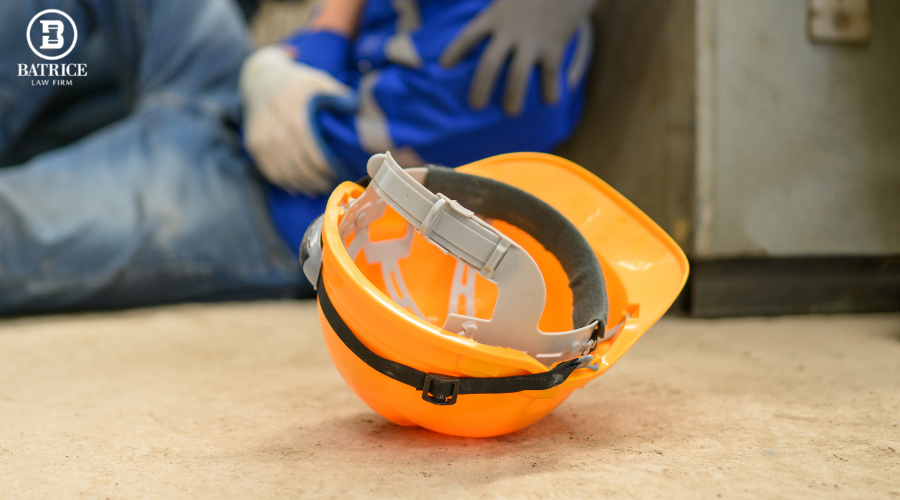Slip and fall accidents can be both shocking and stressful—especially in Texas, where the legal process can be complex. With nearly one million ER visits caused by slips and falls each year in the U.S., these incidents are more serious than many realize.
If you’re injured in a fall, act quickly to protect your rights. Start by documenting the scene with photos of any hazards, and report the incident to the property owner or manager to create an official record. Always seek medical attention, even if you feel fine—some injuries take time to appear, and medical documentation is crucial for any claim.
Preserve evidence by collecting witness statements and, if possible, surveillance footage. In Texas, you have two years to file a lawsuit, but early action can strengthen your case.
Navigating liability and insurance can be challenging, so consider working with a personal injury attorney. They can guide you through the legal process and help you pursue fair compensation. In short, if you’re hurt in a slip and fall, taking the right steps early—documenting, seeking care, preserving evidence, and getting legal help—can make all the difference in your recovery.
Key Highlights
- Document the accident scene right away—take photos, videos, and gather witness details to capture everything accurately.
- Seek medical attention immediately and keep thorough records of all treatments, costs, and any communication with healthcare providers.
- Report the incident to the property owner or manager, and make sure there’s a written record of the report.
- Preserve evidence, such as damaged clothing, shoes, and any surveillance footage that may have recorded the incident.
- Reach out to a personal injury attorney before Texas’s two-year statute of limitations runs out to ensure your rights are protected and to help maximize your compensation.
Understanding Texas Slip and Fall Laws
In Texas, the duty of care that property owners owe to visitors hinges significantly on their status. Invitees—those who enter a property for business purposes—are afforded the highest level of protection. Property owners are required to not only address known dangers but also to perform reasonable inspections to uncover potential risks.
Gathering evidence from witnesses and taking photographs immediately after the incident can significantly strengthen your claim. Additionally, having an experienced personal injury attorney can provide crucial guidance through the complexities of your case. Legal representation is critical, as it can significantly enhance your chances of maximizing compensation for your injuries.
Licensees, such as social guests, are entitled to warnings about hidden dangers but do not require property owners to rectify those hazards. Conversely, trespassers are granted minimal legal protection unless the property owner exhibits gross negligence. This distinction is vital, as it influences the outcome of many slip and fall claims. Victims must file their personal injury claims within two years of the incident to preserve their right to seek compensation.
Furthermore, Texas utilizes a modified comparative fault system, which means that if the injured party is found to share any responsibility for the incident, their compensation could be reduced accordingly. For instance, if a person slips while running through a store, their compensation may decrease based on their level of recklessness.
In situations involving government properties, additional legal protections may come into play, especially regarding recreational activities. This complexity necessitates a thorough understanding of the specific regulations governing each venue when pursuing a claim.
Being informed about these principles not only empowers victims but also serves as a critical reminder for property owners to prioritize safety and compliance. Regular inspections and prompt hazard remediation are not just best practices; they are legal obligations that can shield businesses from liability and protect the well-being of their patrons.
Immediate Actions After Your Fall
When a slip and fall accident occurs, the decisions made in those critical first moments can significantly affect the outcome of any future legal claims. The injured party should prioritize seeking medical attention right away, regardless of whether their injuries seem minor. Prompt evaluation not only ensures proper care but also establishes essential documentation that can support potential claims later on.
Early settlement offers from insurance companies should be carefully considered, as they often try to resolve claims for less than their value. It is essential to follow treatment plans prescribed by healthcare providers to ensure proper recovery and strengthen your case. Additionally, securing professional legal advice can be crucial in navigating potential claims effectively. Moreover, involving an attorney early on can help protect your rights as insurance companies aim to minimize payouts.
Once medical concerns are addressed, it is crucial to document the accident scene thoroughly. This includes photographing or video recording the hazardous conditions that led to the fall, preserving any physical evidence, and gathering contact information from witnesses who can corroborate the event. Additionally, notifying the property owner or manager as soon as possible and providing factual details about the incident creates an official record that can be invaluable.
Keeping detailed records of all communications, medical treatments, and expenses related to the incident is vital for building a solid foundation for potential legal action. It’s wise for the injured party to refrain from discussing the accident on social media or with insurance representatives until they have consulted legal counsel to safeguard their interests.
Documenting the Accident Scene
To establish a compelling legal foundation, accident photography is essential. Capture both wide-angle and close-up shots of hazardous conditions—think wet surfaces, uneven flooring, and inadequate lighting. Make sure to include timestamps to establish when the incident occurred, as this can be pivotal in proving liability. Always document warning signs status to demonstrate whether proper safety precautions were in place. Property maintenance logs should be requested immediately to establish the history of cleaning and repairs.
But don’t stop at photography. Videographic documentation from surveillance cameras can provide insights into how long hazardous conditions existed and how staff responded to the situation. This type of evidence is invaluable in illustrating the sequence of events leading to the accident. Additionally, gathering witness information is critical; eyewitness accounts can offer compelling testimony regarding the duration of hazards and the events surrounding the incident.
It’s also crucial to preserve physical evidence, such as worn clothing or damaged property, which may be analyzed later for forensic insights. When documenting the scene, victims or their representatives should meticulously capture all details regarding environmental conditions, structural defects, and any other contributing factors that may have led to the incident.
Medical Treatment and Record-Keeping
In the aftermath of a slip and fall incident, the hours immediately following the event are crucial. It is essential for victims to seek prompt evaluation at emergency facilities regardless of how minor their injuries seem. Even a seemingly trivial bruise could be hiding a concussion or internal bleeding, which may only reveal itself days later. Medical treatment is vital to prevent potential complications from worsening over time.
Thorough documentation of your medical care is critical, both for your health and for any potential legal claims. Always request detailed incident reports from medical facilities and keep all hospital records and billing statements organized. These documents are not just paperwork; they are key pieces of evidence that create a clear timeline of your injuries and treatments.
The observations made by healthcare providers, along with diagnostic results and treatment recommendations, build an objective record of how the accident has impacted your life. The Texas statute of limitations gives victims only two years to file a lawsuit, making immediate and thorough medical documentation even more crucial. This record can significantly sway the outcome of legal proceedings or insurance claims, making it vital to understand and manage this documentation process effectively.
For business owners, understanding the implications of slip and fall incidents is equally important. The costs associated with these incidents can escalate quickly, impacting both your operations and your bottom line. By being proactive in injury management and documentation, you can navigate the complexities of medical treatment and potential claims more successfully.
Gathering Essential Evidence
Effective documentation goes beyond merely collecting medical records; it encompasses a comprehensive collection of physical evidence. Capturing the scene through photographs and videos is paramount. This means taking wide-angle shots to show the overall environment as well as close-ups that highlight specific hazardous conditions, such as poor lighting or surface defects that contributed to the fall. Detailed written notes are also critical, as they help preserve important information about the timing and specifics of the location. Maintenance logs can reveal patterns of negligence that contributed to unsafe conditions.
Witness statements play a pivotal role in solidifying your case. Gathering contact information and written accounts from bystanders who witnessed the incident can create a clearer narrative of events. These individuals can provide invaluable testimony regarding the hazards that existed at the time of the fall. Expert medical testimony can establish a direct link between the accident and your injuries. Additionally, obtaining a formal incident report from the property owner adds an official record to your documentation. This systematic approach to evidence collection not only strengthens your position but also prepares you for any future legal challenges.
In the fast-paced world of business, being proactive about safety and documentation can mitigate risks and protect your interests. Engaging in these practices not only enhances your credibility but also demonstrates your commitment to maintaining a safe environment for customers and employees alike.
Proving Property Owner Negligence
When a slip and fall accident occurs on someone else’s property, the question of negligence often emerges as a critical concern for victims seeking justice. To successfully prove that a property owner is liable for negligence, several key elements must be established. First and foremost, it’s essential to demonstrate that the property owner owed a duty of care to the victim. This duty involves maintaining a safe environment and identifying potential hazards. If the owner fails to uphold this duty, they may be deemed negligent.
Evidence is crucial in these cases. The plaintiff must show that the property owner had either actual or constructive knowledge of the dangerous condition that caused the fall. This knowledge can be substantiated through a variety of means, such as maintenance records indicating prolonged neglect, surveillance footage capturing the incident, or witness statements corroborating the existence of the hazard. For example, if a spill was present for an extended period without being addressed, this may indicate negligence on the owner’s part.
Moreover, it’s vital to link the injury directly to the hazardous condition, ensuring that external factors or pre-existing medical issues did not contribute to the incident. Property owners often mount defenses against negligence claims by asserting that the hazard was open and obvious, arguing that the victim assumed the risk, or claiming that they acted promptly to rectify the dangerous situation upon discovery.
Understanding these elements can empower business owners to take proactive measures in maintaining their properties and minimizing liability risks. By staying informed and diligent, property owners can create a safer environment while mitigating the risk of costly negligence claims.
Calculating Your Claim’s Value
Determining the worth of a slip and fall claim is a multifaceted process, requiring a keen evaluation of both economic and non-economic damages. Economic damages are tangible losses that can be easily quantified—think medical expenses, lost wages, and any property damage incurred. On the other hand, non-economic damages cover the more subjective impacts, such as pain and suffering, emotional distress, and diminished quality of life.
In Texas, a unique multiplier system is employed to assess these non-economic damages, typically ranging from 1.5 to 5 times the amount of economic losses. This could mean that a claim with significant medical bills could translate into a much larger payout when considering emotional and psychological impacts.
However, it’s crucial to remember that Texas follows a modified comparative fault rule. This means that if a plaintiff is found to be 50% or more responsible for their fall, they lose their right to compensation. This aspect can create tension and uncertainty, making it essential to have strong evidence and clear documentation to support your case. While Texas does not impose caps on damages for slip and fall cases, the final settlement amount often hinges on the defendant’s insurance coverage limits and the robustness of your evidence, including medical records and expert testimony.
Ensuring that you have proper safety measures in place can not only help prevent accidents but also protect your business from potential liabilities. Stay informed, maintain thorough documentation, and consult with legal professionals to navigate this complex landscape effectively.
Navigating Insurance Company Negotiations
Insurance companies frequently employ methods designed to minimize their payouts, such as offering quick, lowball settlement offers and attempting to deflect liability away from themselves. For victims, it’s essential to arm themselves with thorough documentation and to resist the temptation of accepting premature agreements.
Successful negotiation hinges on the ability to present comprehensive evidence—this includes not only medical records and incident reports but also expert analyses that can bolster your case. When faced with adjusters who may delay proceedings or raise questions about liability, having a well-organized set of documentation can significantly enhance your negotiating power.
If you’ve kept meticulous records of your interactions with the insurance company and tracked all related expenses, you are in a much stronger position. Legal representation can provide an additional layer of advocacy, managing communications, structuring settlement demands, and preparing for litigation if the situation calls for it.
By documenting all interactions and responding strategically to their settlement offers, you can work toward obtaining fair compensation. This approach not only helps avoid typical pitfalls in the claims process but also ensures that you are equipped to handle any challenges that arise along the way.
Time Limits for Filing Your Claim
For most personal injury cases, you have just two years from the date of the accident to take legal action. This narrow window can feel overwhelming, and missing it often means forfeiting your right to compensation, leaving many victims in a precarious financial situation. In addition to the standard two-year deadline, claims involving government property require you to provide notice within six months. It’s crucial to understand these timelines so you can act swiftly and effectively.
There are exceptions that may adjust these deadlines. For example, if the injured party is a minor, the clock doesn’t start ticking until they turn 18. Similarly, individuals with mental incapacity may find their deadlines paused. The discovery rule can also come into play, allowing for extensions if injuries become apparent only after the accident. However, be aware that a 10-year statute of repose imposes an absolute limit on all claims, regardless of circumstances.
Failing to meet these deadlines can lead to automatic dismissal of your case, effectively erasing any chance of recovery. Courts in Texas uphold these limitations rigorously, even when liability appears clear, underscoring the importance of understanding and adhering to these critical timeframes.
In light of these details, it’s imperative that you consult with a legal professional as soon as possible after an incident. This proactive approach can help you navigate the complexities of your claim and ensure that you meet all necessary deadlines, allowing you to focus on your recovery rather than the intricacies of the legal process.
Working With a Texas Personal Injury Attorney
A skilled personal injury attorney will adeptly handle the intricate details of your claim, from preserving vital evidence to coordinating with expert witnesses and negotiating with insurance companies. They act as a protective barrier against potentially damaging statements or inadequate settlement offers that could undermine your case.
Most attorneys work on a contingency fee basis, meaning they only collect payment if your case is successful—typically taking between 33% to 40% of the settlement amount. This model allows victims to secure high-quality legal representation without the burden of upfront costs, alleviating some of the financial stress that often accompanies such situations.
Professional case management is essential. It involves meticulous documentation of your damages, strategic communication with the defendant, and thorough preparation of legal arguments to prove liability. Your attorney becomes both your advocate and shield, managing complex negotiations so that you can focus on recovery. Their experience is particularly invaluable when facing defense tactics or deciding whether to settle or proceed to trial.
For business owners, the implications of a slip and fall incident can extend beyond personal injury claims. A single incident can impact your reputation, customer trust, and even lead to increased insurance premiums. Having a competent attorney by your side can not only help you navigate these challenges but also safeguard your business interests in the long run.
In Summary
Experiencing a slip and fall accident in Texas can lead to overwhelming feelings, but you can regain control by following legal protocols. Proper documentation of the incident is crucial, as it forms the foundation of your case and helps in negotiating with insurance companies effectively.
Additionally, being mindful of filing deadlines ensures that you do not miss out on your opportunity for compensation. Should you find yourself in a challenging situation, consider reaching out to Batrice Law Firm, the premier personal injury attorney in Austin, Texas, to guide you through the process.
At Batrice Law Firm, we understand the complexities of slip and fall cases and are committed to helping you navigate them successfully. Our experienced team is dedicated to ensuring that you receive the support and compensation you deserve for your injuries. We prioritize your needs and work diligently to advocate on your behalf.
Visit our website to learn more about how we can assist you in achieving a favorable resolution for your slip and fall accident.




